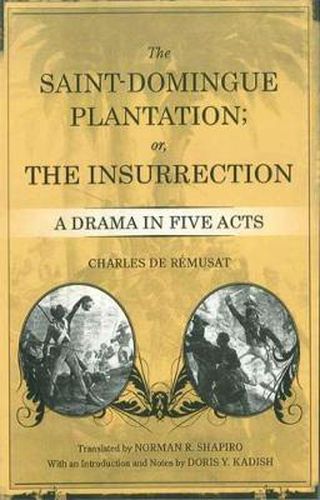Readings Newsletter
Become a Readings Member to make your shopping experience even easier.
Sign in or sign up for free!
You’re not far away from qualifying for FREE standard shipping within Australia
You’ve qualified for FREE standard shipping within Australia
The cart is loading…






This title is printed to order. This book may have been self-published. If so, we cannot guarantee the quality of the content. In the main most books will have gone through the editing process however some may not. We therefore suggest that you be aware of this before ordering this book. If in doubt check either the author or publisher’s details as we are unable to accept any returns unless they are faulty. Please contact us if you have any questions.
Based on events that began in Saint-Domingue on August 21, 1791, The Saint-Domingue Plantation; or, The Insurrection vividly dramatizes the genesis and outbreak of a slave revolt. When a representative of the French Assembleia ©e nationale, Monsieur de Tendale, arrives at the Valombre family plantation to examine the condition of slaves in Saint-Domingue and to preach their liberation, he sparks a debate among the local curA © and the Valombres – Monsieur, Madame, son leia ©on, and daughter CA ©lestine – who disagree about how slaves should be treated and whether they should be freed. Meanwhile, rebellion brews on the plantation. As the slave revolt unfolds, the play’s white hero, leia ©on, realizes the discrepancy between his liberal political and philosophical ideas and the reality of his family’s economic interests. The black hero, Timur, confronts the slaves’ bloodthirsty desire to kill the masters, their resistance to his leadership, and the realization that freedom places heavy demands on him and the other insurgents.Translated into English by Norman R. Shapiro for the first time since its publication in 1825, The Saint-Domingue Plantation addresses a wide range of topics that antislavery activists raised during Charles de RA ©musat’s time, including antitorture measures, slaves’ access to the sacrament of marriage, and religious education. An informative introduction by Doris Y. Kadish places the play in its historic and literary contexts, inviting further discussion and interpretation of this important work.
$9.00 standard shipping within Australia
FREE standard shipping within Australia for orders over $100.00
Express & International shipping calculated at checkout
This title is printed to order. This book may have been self-published. If so, we cannot guarantee the quality of the content. In the main most books will have gone through the editing process however some may not. We therefore suggest that you be aware of this before ordering this book. If in doubt check either the author or publisher’s details as we are unable to accept any returns unless they are faulty. Please contact us if you have any questions.
Based on events that began in Saint-Domingue on August 21, 1791, The Saint-Domingue Plantation; or, The Insurrection vividly dramatizes the genesis and outbreak of a slave revolt. When a representative of the French Assembleia ©e nationale, Monsieur de Tendale, arrives at the Valombre family plantation to examine the condition of slaves in Saint-Domingue and to preach their liberation, he sparks a debate among the local curA © and the Valombres – Monsieur, Madame, son leia ©on, and daughter CA ©lestine – who disagree about how slaves should be treated and whether they should be freed. Meanwhile, rebellion brews on the plantation. As the slave revolt unfolds, the play’s white hero, leia ©on, realizes the discrepancy between his liberal political and philosophical ideas and the reality of his family’s economic interests. The black hero, Timur, confronts the slaves’ bloodthirsty desire to kill the masters, their resistance to his leadership, and the realization that freedom places heavy demands on him and the other insurgents.Translated into English by Norman R. Shapiro for the first time since its publication in 1825, The Saint-Domingue Plantation addresses a wide range of topics that antislavery activists raised during Charles de RA ©musat’s time, including antitorture measures, slaves’ access to the sacrament of marriage, and religious education. An informative introduction by Doris Y. Kadish places the play in its historic and literary contexts, inviting further discussion and interpretation of this important work.